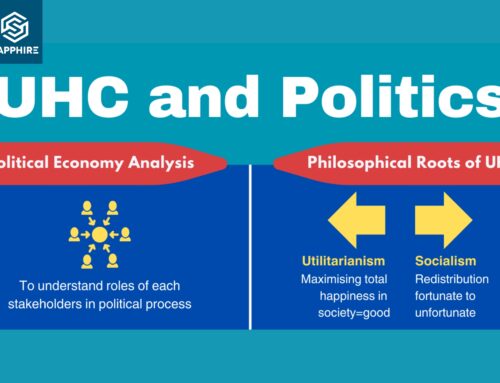
This essay is one in a series of essays published by HITAP from students who studied the Masters in Primary Health Care Management at the ASEAN Institute for Health Development and Faculty of Graduate Studies at Mahidol University. HITAP staff assisted in teaching on the course ADPM 613 Health Economics, and the essays featured on the HITAP website were examination answers submitted by students on the course.
Health insurance system is a means through which risks can be shared and compensated at the population level, from healthy to sick, employed to unemployed, adults to elderly and children. It plays a significant role in our journey towards achieving universal health coverage (UHC) by providing affordable and equitable services for all. The social return on investment from public health policies such as UHC can be transforming at individual and national level from both health and economic perspectives. However, in 2010, 808 million people (globally) still incurred catastrophic health expenditure (CHE) [1]. Therefore, increasing the share of GDP spend on health and the share of total health expenditure (THE) should be a priority for all countries.
A glimpse of health insurance system in Nepal
With the objective of increasing access and utilization of essential and quality health services, the National Health Insurance Policy (NHIP) was endorsement in Nepal by the cabinet in April 2014. The Health Insurance Board (HIB) is responsible for implementing this policy and sits under the Department of Health Services (DoHS), Government of Nepal. Currently the scheme has been scaled in 50 (out of 77) districts. Enrollment into the scheme is done at the household level with a premium of NPR 3,500 (approx. 35 USD) per year for a family of five, or NPR 700 (approx. 5 USD) per person if more than 5 members in the family and eligible to receive care up to NPR 100,000 (approx. 1000 USD). Additional NPR 100,000 for each elderly member of the family and NPR 100,000 for patients with eight chronic diseases is made available under this scheme. There is also a provision for free essential drugs and free treatment for patients with cardiovascular disease, cancer, spinal injuries, renal ailments, and sickle cell anaemia made available through the Disadvantaged Citizens Medical Treatment Fund. More than one-third covered in this scheme are subsidy enrollment i.e., free enrollment for vulnerable groups [2]. The scheme is expected to reduce the burden of out of pocket (OOP) (currently more than two-third) and CHE (40% threshold is >1%) and improve the UHC index (46) [3].
What are the hurdles?
While the NHIP is a considerable step towards a sustainable and equitable provision of healthcare in Nepal, many challenges remain. The expansion of the scheme has been slow with national coverage in 2019 at only 11% and dropout rate 38% [4]. These reflect the lack of attention paid to both supply side (limited benefits package, tedious enrollment process, long maturity to activate health services of 3 months, lack of copayment in various services, unequal distribution of healthcare services and their quality across districts, poor infrastructure, inadequate supply of essential drugs, insufficient budget allocation, poor retention of human resources in rural districts) and demand side (socio-economic factors such as education and economic status which contribute to recognition for the need of health insurance, as well as access to health facilities) when implementing the scheme [4]. Given these issues, it is unlikely that Nepal will achieve its goal of covering 90% of its population under UHC by 2030.
Health insurance system in other settings
There are several countries from which Nepal could draw lessons from. Germany has the one of the oldest government-regulated statutory health insurance system, with mandatory health insurance enrollment for all workers below an income threshold enacted under Chancellor Otto von Bismarck in 1883. Recently, the German health insurance system has undergone substantial reform of financial contribution policies for social health insurance (SHI), regulations for private health insurance providers aimed at improving the affordability of private health insurance, and the introduction of a statutory insurance requirement for all to ensure universality. In Singapore, the centerpiece of its health insurance system is a mandatory income-based individual savings program, which is known as Medisave, that requires consumers to contribute 6% to 9% of their income to a health savings account. There is a complementary insurance plan, known as Medishield, which is available to cover a percentage of expenses arising from prolonged hospitalization or extended outpatient treatments for specified chronic illnesses. The government also supports a second complimentary catastrophic spending insurance program, known as Medifund, which exists to help consumers when their Medisave and Medishield are inadequate. Thailand has three schemes: (1) civil servants medical benefit scheme (CSMBS) funded through general taxation and Ministry of Finance for government employees, pensioners, and their dependents, (2) social security scheme (SSS) funded through a tripartite system between employer, employees, and Ministry of Labour, for formal and private sector employees, and (3) universal coverage scheme (UCS) funded through general taxation for those not covered under CSMBS and SSS.
Lessons for Nepal
The current health insurance system in Nepal is not sufficient to cover its population and lacks a process to ensure the interventions included in the benefits package provide the best value for money. Germany, Singapore, and Thailand, where coverage level and health outcomes are incomparable to Nepal, have showcased the need for multiple insurance schemes to ensure financial sustainability (generate revenue based on ability to pay) and improve uptake and coverage (by providing options to opt into various schemes, especially to those who can pay higher premium). This is especially relevant in Nepal where households OOP payment for healthcare is the largest source of healthcare spending (57.4%) and 85% of total OOP expenditure are made at private hospitals [5]. At present, those unwilling to enroll or have dropped out from the social health insurance in Nepal are wealthy, government employees, local politicians, and migrants [4]. All forementioned countries also apply health technology assessment (HTA), which is a multidisciplinary process that uses explicit methods to determine the value of a health technology (intervention) when informing the benefits package. The government of Nepal should pay urgent attention to introducing HTA which can promote equitable, efficient, and high-quality health system. Therefore, continued investment into the health sector with careful consideration into both demand and supply and a mechanism to ensure resources are used efficiently could improve Nepal health insurance system and improve population health and wellbeing.
- Wagstaff, A., et al., Progress on catastrophic health spending in 133 countries: a retrospective observational study. The Lancet Global Health, 2018. 6(2): p. e169-e179.
- Government of Nepal, Health Insurance Board (HIB). Annual Report. Teku, Kathmandu; 2018
- World Bank. Data Calalogue. 2019; https://datacatalog.worldbank.org/country/nepal.
- Ranabhat, C.L., Subedi, R. & Karn, S. Status and determinants of enrollment and dropout of health insurance in Nepal: an explorative study. Cost Eff Resour Alloc 18, 40 (2020). https://doi.org/10.1186/s12962-020-00227-7
- MoHP (2019). Nepal National Health Accounts 2016/17, Ministry of Health and Population, Government of Nepal, Kathmandu, Nepal
Edited by: Sarin KC, HITAP



